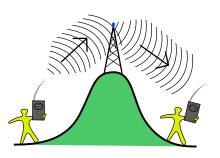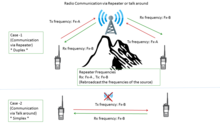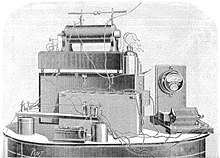Repeater

In
There are several different types of repeaters; a telephone repeater is an
that retransmits a radio signal.A broadcast relay station is a repeater used in broadcast radio and television.
Overview
When an information-bearing signal passes through a
The term "repeater" originated with
Use of the term has continued in telephony and data communications.
In
Types
Telephone repeater
This is used to increase the range of telephone signals in a telephone line.
- Land line repeater
They are most frequently used in trunklines that carry long distance calls. In an analog telephone line consisting of a pair of wires, it consists of an amplifier circuit made of transistors which use power from a DC current source to increase the power of the alternating current audio signal on the line. Since the telephone is a duplex (bidirectional) communication system, the wire pair carries two audio signals, one going in each direction. So telephone repeaters have to be bilateral, amplifying the signal in both directions without causing feedback, which complicates their design considerably. Telephone repeaters were the first type of repeater and were some of the first applications of amplification. The development of telephone repeaters between 1900 and 1915 made long-distance phone service possible. Now, most telecommunications cables are fiber-optic cables which use optical repeaters (below).
Before the invention of electronic amplifiers, mechanically coupled
- Submarine cable repeater
This is a type of telephone repeater used in underwater
Optical communications repeater
This is used to increase the range of signals in a
Radio repeater


This is used to extend the range of coverage of a radio signal. The history of radio relay repeaters began in 1898 from the publication by Johann Mattausch in Austrian Journal Zeitschrift für Electrotechnik (v. 16, 35 - 36).[2][4] But his proposal "Translator" was primitive and not suitable for use. The first relay system with radio repeaters, which really functioned, was that invented in 1899 by Emile Guarini-Foresio.[2]
A radio repeater usually consists of a radio receiver connected to a radio transmitter. The received signal is amplified and retransmitted, often on another frequency, to provide coverage beyond the obstruction. Usage of a duplexer can allow the repeater to use one antenna for both receive and transmit at the same time.
- Broadcast relay station, rebroadcastor or translator: This is a repeater used to extend the coverage of a radio or television broadcasting station. It consists of a secondary radio or television transmitter. The signal from the main transmitter often comes over leased telephone lines or by microwave relay.
- Microwave relay: This is a specialized point-to-point telecommunications link, consisting of a microwave receiver that receives information over a beam of microwaves from another relay station in line-of-sightdistance, and a microwave transmitter which passes the information on to the next station over another beam of microwaves. Networks of microwave relay stations transmit telephone calls, television programs, and computer data from one city to another over continent-wide areas.
- Passive repeater: This is a microwave relay that simply consists of a flat metal surface to reflect the microwave beam in another direction. It is used to get microwave relay signals over hills and mountains when it is not necessary to amplify the signal.
- cell tower, an amplifier, and a local antenna to rebroadcast the signal to nearby cell phones. It is often used in downtown office buildings.
- Digipeater: A repeater node in a packet radio network. It performs a store and forward function, passing on packets of information from one node to another.
- Amateur radio repeater: Used by amateur radio operators to enable two-way communication across an area which would otherwise be difficult by point-to-point on VHF and UHF. These repeaters are set up and maintained by individual operators or clubs, and are generally available for any licensed amateur to use. A hill or mountaintop location is a preferable location to construct a repeater, as it will maximize the usability across a large area.
Radio repeaters improve communication coverage in systems using frequencies that typically have line-of-sight propagation. Without a repeater, these systems are limited in range by the curvature of the Earth and the blocking effect of terrain or high buildings. A repeater on a hilltop or tall building can allow stations that are out of each other's line-of-sight range to communicate reliably.[5]
Radio repeaters may also allow translation from one set of radio frequencies to another, for example to allow two different public service agencies to interoperate (say, police and fire services of a city, or neighboring police departments). They may provide links to the public switched telephone network as well,
Typically a repeater station listens on one frequency, A, and transmits on a second, B. All mobile stations listen for signals on channel B and transmit on channel A. The difference between the two frequencies may be relatively small compared to the frequency of operation, say 1%. Often the repeater station will use the same antenna for transmission and reception; highly selective filters called "duplexers" separate the faint incoming received signal from the billions of times more powerful outbound transmitted signal. Sometimes separate transmitting and receiving locations are used, connected by a wire line or a radio link. While the repeater station is designed for simultaneous reception and transmission, mobile units need not be equipped with the bulky and costly duplexers, as they only transmit or receive at any time.
Mobile units in a repeater system may be provided with a "talkaround" channel that allows direct mobile-to-mobile operation on a single channel. This may be used if out of reach of the repeater system, or for communications not requiring the attention of all mobiles. The "talkaround" channel may be the repeater output frequency; the repeater will not retransmit any signals on its output frequency.[9]
An engineered radio communication system designer will analyze the coverage area desired and select repeater locations, elevations, antennas, operating frequencies and power levels to permit a predictable level of reliable communication over the designed coverage area.
Data handling
Repeaters can be divided into two types depending on the type of data they handle:
Analog repeater
This type is used in channels that transmit data in the form of an
Digital repeater
The digital repeater is used in channels that transmit data by
See also
- 12-channel carrier system
- ADSL loop extender
- Complementary ground component
- Fiber media converter
- PLC carrier repeating station
- Relay (disambiguation)
- Repeater insertion in integrated circuits
- Signal strength
- Transponder
- Wireless distribution system
- Wireless repeater
References
- ^ Loring, A. E.E (1878). A Hand-book of the Electro-Magnetic Telegraph. New York: D. Van Nostrand. pp. 53–54.
- ^ a b c Slyusar, Vadym (2015). "First Antennas for Relay Stations" (PDF). International Conference on Antenna Theory and Techniques, 21–24 April 2015. Kharkiv, Ukraine. pp. 254–255. Archived (PDF) from the original on 24 September 2015. Retrieved 10 August 2017.
- ISBN 0262082985.
- ^ Mattausch J. Telegraphie ohne Draht. Eine Studie. // Zeitschrift für Elektrotechnik. Organ des Elektrotechnischen Vereines in Wien.- Heft 3, 16. Jänner 1898. - XVI. Jahrgang. - S. 35–36.[1] Archived 2017-08-06 at the Wayback Machine
- ^ "Radio Awareness about Communications Systems - HOW DO REPEATER SYSTEMS WORK?". .taitradioacademy.com/. 22 October 2014. Archived from the original on 2017-09-04. Retrieved 2017-08-23.
- ^ "Radio Interoperability Communications Systems -". basecampconnect.com. Archived from the original on 2017-09-04. Retrieved 2017-08-23.
- ^ "Radio Interoperability - TELEPHONE INTERCONNECT-". codanradio.com/. Archived from the original on 2017-09-04. Retrieved 2017-08-23.
- ^ "Tactical Voice Communications Solutions for HLD/HLS" (PDF). c-at.com. Archived (PDF) from the original on 2022-10-09. Retrieved 2017-08-23.
- ISBN 0131231596, p. 67-75.
External links
- The Bell system technical journal: Repeaters and Equalizers for the SD Submarine Cable System
- Amateur Radio Repeaters in India Archived 2017-07-05 at the Wayback Machine
- Amateur Radio Repeaters in Europe
